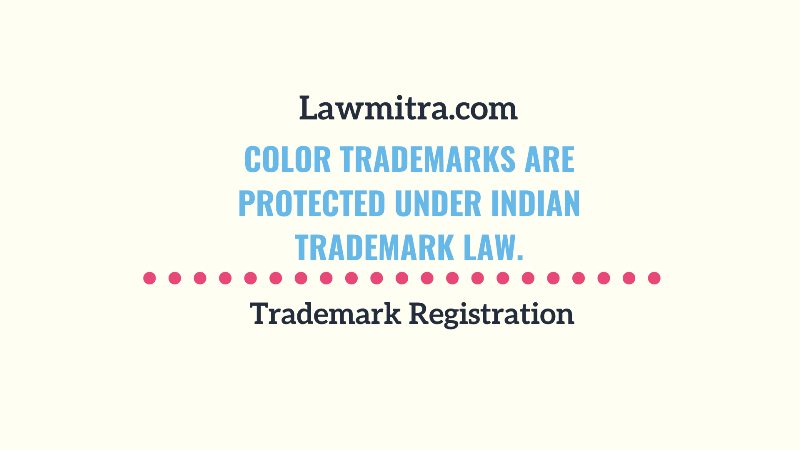Table of Contents
ToggleColor Trademarks are protected under Indian trademark law.
A trademark is a distinctive expression, design, or sign that identifies and distinguishes a single source’s products or services from those of others. A trademark might be found on the product’s packaging, voucher, label, or packing. Various types of trademarks can be registered, including Motion marks, sound marks, scent marks, color marks, hologram marks, shape marks, 3D marks, position marks, taste marks, and texture marks are examples of non-traditional or non-conventional trademarks. Only if a single shade or color combination of a product’s packaging can be recognized by the general public as unique or belonging to a specific brand can it be granted Trademark Protection. A few examples are Ferrero Rocher’s golden and brown blend, Cadbury’s purple, Tiffany’s blue, and other well-known color trademarks.
The Trade Marks Act of 1999 (hereafter referred to as the ‘Act’) protects the owner’s exclusive Trademark Rights to use the mark in India, preventing any unauthorized or illegal use from confusing the general public. Its goal is to promote items or services in the marketplace while preventing competitors from infringing on the trademark and profiting from it. It also motivates businesses and consumers to protect their interests in the market.
Any term, label, name, device, brand, ticket, signature, heading, letter, numeral, product shape, packaging, color combination, or any color combination can be registered as a trademark under Section 2(1)(zb) of the Act. However, complexities and issues develop in circumstances outside the scope of standard or conventional trademarks, for which registration is difficult to get exclusive status.
Legal Provisions on Color Trademarks in India
The terms “combination of colors” or “any combination thereof” are included in the definitions of the terms “trademark” or “mark.” A color is intrinsically obscure under the Act, yet, with enough acquired meaning, a color combination might obtain distinctiveness and be registered as a trademark. Only if it can be proven that a specific color combination is closely associated with the brand or product in the subject and that exact combination can identify the brand or product may a unique color combination be granted trademark protection.
Using colors to perform the trademark function of distinctly or uniquely determining the commercial source of the products or services in question is required to prove the distinctiveness or originality of a proposed color trademark. Adopting a distinctive or unique color combination helps the general public connect with the items or services, increasing the market worth of a particular source while preventing others from profiting from the distinctive mark.
When filing a Trademark Registration Application for a color mark, the applicant must describe that the color or combination of colors is entirely connected with him. The general public associates the color or variety of colors with the items or services listed in the application. Further, Public polls establishing the relationship of the color or combination of colors with the applicant’s trademark can be used to present the piece of proof.
It’s important to remember that obtaining trademark protection for a color mark without sufficient supporting proof can be challenging. In this case, the trademark applicant must show that the specific color combination or color has gained distinctiveness in the course of trade or has acquired secondary significance due to bona fide uninterrupted use. For example, while ‘Orange’ as a trademark for a drink may be distinctive, the orange shade claimed for the drink’s bottle packaging would be non-distinctive.
Courts’ Verdict on Color Marks
Cadbury UK Limited vs. The Comptroller General Of Patents, Designs, And Trademarks & Société Des Produits Nestlé S.A. (A3/2016/3082)
Cadbury, a British global confectionery firm, demonstrated in this case that its distinctive and unique purple tint, Pantone 2865C, used on the packaging of its milk chocolate wrappers, had developed a particular character over time. After a lengthy legal battle with Nestle, a Swiss multinational food and drink processing company, a public poll was submitted as proof of support. The equivalent was granted on October 1, 2012.
Indian Courts’ Verdict on Color Marks Anchor Health & Beauty Care Pvt. Ltd. vs. Colgate Palmolive Company, 2003 (27) PTC 478 Del
Colgate sought an ad-interim injunction in this action to prevent the use of trade dress and a color combination of one-third red and two-thirds white on the container of the product, Tooth Powder, in a specific sequence. It claimed that the defendant, Anchor Health & Beauty Care, used identical trade dress, notably the red and white color scheme, to pass off Colgate’s product as its own.
In this instance, the Court concluded that the general impression that a client gets about the source or origin of the item comes from the visual appearance of a color blend, the shape of the container, the packing, etc. It has been ensured that if the mere sight of a product gives the impression of any deceptive resemblance, it will undoubtedly create confusion and tarnish the original product’s image.
The Indian Judiciary recognized color as an essential aspect of trade dress in this case. It awarded its protection by prohibiting Anchor from utilizing the red and white color combination on the container and packaging described as a trade dress.
Last Thoughts
When it comes to color marks (which fall under the category of non-conventional trademarks), the courts have made it very apparent that the standard of distinctiveness is highly stringent. As a result, registering a color combination necessitates the presence of some ‘plus element’ or secondary meaning to the hue when it is related to the product in question. Please keep in mind that there is no definitive test for whether a color combination has acquired distinctiveness; it all relies on how customers perceive the color combination and how the courts capture it.


